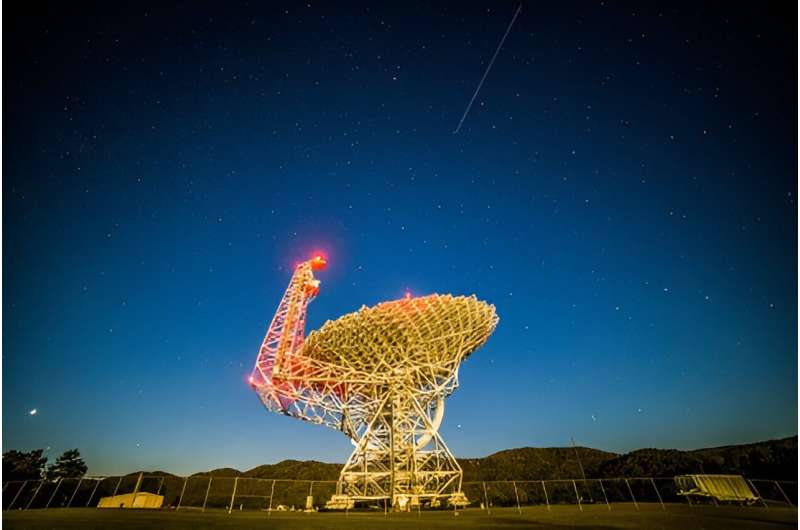This article has been reviewed according to Science X's editorial process and policies. Editors have highlighted the following attributes while ensuring the content's credibility:
fact-checked
peer-reviewed publication
trusted source
proofread
Astronomers, satellite internet provider develop new system to share the sky

Astronomers learn about the universe by pointing their telescopes to the sky. But what happens when a satellite comes between them and the cosmological objects they hope to study?
New cooperative work between the U.S. National Science Foundation National Radio Astronomy Observatory (NSF NRAO) and SpaceX shows a way to share this finite resource between radio astronomers and industry.
The NSF NRAO manages some of the most important and sensitive radio telescopes in the world. To protect their observations from interference from a variety of human-made technology, these instruments are located in rugged and remote locations, like the Appalachian Mountains and the high plains of the New Mexico desert.
The innovation of satellite internet, like SpaceX's Starlink, has made high speed internet access available to Americans across the country, including remote locations like these. However, the benefits of this internet access come at a cost: satellite transmissions that cross the paths of radio telescopes can drown out the faint signals being observed from space.
Scientists and engineers of both organizations are working closely together to provide internet connectivity where it's needed most, and ensure that astronomers can continue to observe in the presence of these satellites and their transmissions.
SpaceX first signed a coordination agreement with the NSF and its radio observatories in 2019 to explore solutions to share the sky. Since that time, continued tests and experiments, along with updates to this agreement, have expanded the range of protected radio astronomy bands beyond what is required by international guidelines.
These tests and experiments have also included dynamic coordination between Starlink and key NSF instruments, such as the Very Large Array (VLA), Very Long Baseline Array (VLBA), Green Bank Observatory (GBO), and geodetic Very Long Baseline Interferometric (VLBI) stations.
For the majority of residents in the National Radio Quiet Zone (NRQZ), a special zone where radio wavelengths are carefully managed to prevent interference to the NSF Green Bank Observatory and other nearby federal facilities, SpaceX will soon be able to safely provide either fixed or roaming/mobile Starlink access through a new process called telescope boresight avoidance.
The NRQZ regulations call for coordination of all fixed licensed transmitters, especially those nearby radio telescopes, which includes the SpaceX fixed user terminals. However, through the NSF and SpaceX collaboration, Starlink will now be able to provide satellite internet to nearly all residents without causing significant interference to observations.
Telescope boresight avoidance, a new coexistence method between the telescopes and the satellites, is one of two major developments in this collaboration that will allow the satellites to provide high speed internet connectivity near radio telescopes while protecting important scientific research. This method is made possible by an autonomous framework called the Operational Data Sharing (ODS) system developed by the NRAO that allows for communication between the telescopes and the satellite network.
ODS autonomously informs the Starlink satellites about the current observations of the NSF NRAO telescopes, including pointing direction, frequency of observation, and bandwidth. The satellites read this information in real time and ensure that their downlinks (particularly from satellites close in the region of the sky where the telescopes are pointing) do not emit signals strong enough to disrupt observations.
Chris De Pree, National Radio Dynamic Zone Project Director, adds, "While we are still testing the system, this is a major achievement, and a clear example of the benefits of regular communication and experimentation involving active and passive users of the radio spectrum."
Ashley VanderLey, a NSF Senior Advisor adds, "This work is the culmination of years of ongoing commitment to scientific discovery by the satellite industry, together with years of Federal investment under the U.S. NSF Spectrum Innovation Initiative, and is an excellent example of the dynamic spectrum sharing called for in the U.S. government's National Spectrum Strategy."
NSF NRAO hopes this newly developed Telescope Boresight Avoidance method will be beneficial to mitigating the impact of Starlink and other satellite operators on telescopes across the U.S. and potentially around the globe, and the first scientific paper describing these systems and experiments has been accepted for publication in the Astrophysical Journal Letters and is available on the arXiv preprint server.
Bang Nhan, lead author and NSF NRAO Assistant Scientist in Spectrum Management adds, "We hope ODS will provide a framework for other radio observatories and satellite constellations to share the skies, and work side-by-side in the coming decades."
More information: Bang D. Nhan et al, Toward Spectrum Coexistence: First Demonstration of the Effectiveness of Boresight Avoidance between the NRAO Green Bank Telescope and Starlink Satellites, arXiv (2024). DOI: 10.48550/arxiv.2407.21675
Journal information: Astrophysical Journal Letters , arXiv
Provided by National Radio Astronomy Observatory




















